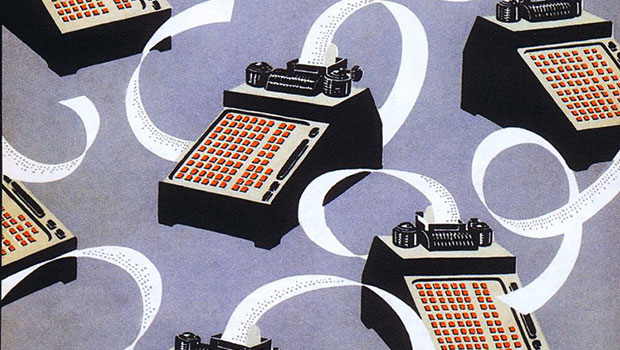Scanning Around With Gene: The Stylish Covers of Fortune

Originally published February 12, 2012
I’ve long wanted to do a column on the covers of Fortune magazine, especially those published before 1960 when the magazine was one of the most lavishly produced in the United States. However, because the magazine began publishing in 1930, it was difficult to edit the many possibilities down to a manageable number for presentation here.
But I finally whittled down the images and chose some favorites. These covers are from a number of sources, including my own collection, Web archives, and a terrific book (out-of-print but still available at Amazon), FORTUNE The Art of Covering Business. Click on any image for a larger version.
Fortune magazine was founded in 1930 by Henry Luce, who had earlier co-founded Time magazine with Briton Hadden. When he presented the idea for Fortune to the board at Time, Inc., he quoted Leonardo de Vinci: “The eye giveth to man a more perfect knowledge than doth the ear. That which is seen is more authentic than that which is heard.”
Luce went on to say that “the new magazine will be as beautiful a magazine as exists in the United States. If possible, the undisputed most beautiful.” Many magazine buffs feel he easily accomplished that feat.
The first cover illustration and art direction for the magazine was done by T.M. Cleland, though by the fourth issue he had turned over art direction to his protégé, Eleanor Treacy. Luce encouraged fine art, the best photography, and spectacular print reproduction.
In fact, Fortune was such a difficult print job that the work had to be spread among several New York printers. The cover was printed on 125-pound stock, and the 11×14-inch size and large number of pages required each issue be stitched together by hand.
From the start, Fortune was expensive: $1 per copy or ten dollars a year for a subscription. A Sunday New York Times of that era was 5 cents. Despite the price, up to 30,000 people signed on for the first issue.
The stock market crashed just as the first issue was in the planning stages but Luce and crew carried on, determined to present business in an artistic and high-quality light. The unfortunate economic timing didn’t end up dimming the magazine’s success.
In that first issue, Luce wrote, “Fortune‘s purpose is to reflect industrial life in ink and paper and word and picture as the finest skyscraper reflects it in stone and steel and architecture.”
Throughout the years Fortune not only presented fantastic covers, often by well-known artists of the time, but dramatic photographs from the likes of Margaret Bourke-White and provocative writing from many of the best-known contemporary authors.
The inside pages were as lavishly designed as the covers. The oversized spreads made for dramatic presentations, and even advertisers got on board with unusual layouts that focused on art as much as copy. (I’ll look at Fortune ads in a future column.)
Early issues of Fortune are prized by collectors and I don’t have nearly as many as I’d like. They’re not only beautiful, but the ads and editorial content are interesting reads, as well.
Like most publications, Fortune was downsized over the decades and while it still exists, it’s a shadow of its former self. The original vision to publish the world’s most beautiful magazine has long faded, a victim of changing times and publishing economics.
But if you ever get a chance to pick up any old copies of Fortune, by all means do. You won’t be disappointed.
Special Note: Last week marked my nine-year anniversary writing these columns for CreativePro.com. For the vast majority of that time it has been my pleasure and fortune to work with editor in chief Terri Stone, who is leaving for a great new opportunity. My thanks go out to her, who is not only a talented and gifted editor, but a supportive and understanding friend. I would have never made it for nine years without Terri’s terrific work and kindness. I will miss our weekly interactions but expect our friendship to live on long after our writer/editor relationship ends.
This article was last modified on February 28, 2021
This article was first published on March 11, 2016



























